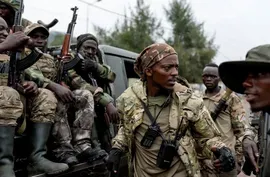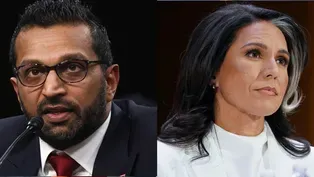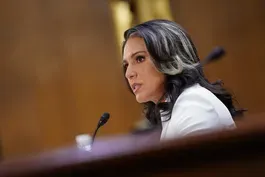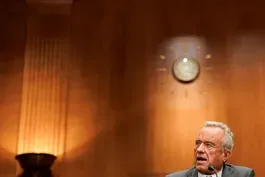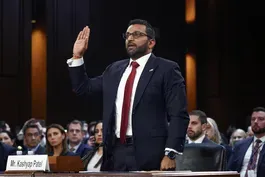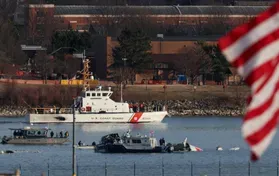
What led up to the worst U.S. aviation disaster since 2001
Clip: 1/30/2025 | 6m 23sVideo has Closed Captions
Breaking down the moments that led up to the worst U.S. aviation disaster since 2001
The mid-air collision between a passenger jet and a military helicopter near Washington has left many searching for answers. To break down the crash, Geoff Bennett spoke with aviation correspondent Miles O'Brien.
Major corporate funding for the PBS News Hour is provided by BDO, BNSF, Consumer Cellular, American Cruise Lines, and Raymond James. Funding for the PBS NewsHour Weekend is provided by...

What led up to the worst U.S. aviation disaster since 2001
Clip: 1/30/2025 | 6m 23sVideo has Closed Captions
The mid-air collision between a passenger jet and a military helicopter near Washington has left many searching for answers. To break down the crash, Geoff Bennett spoke with aviation correspondent Miles O'Brien.
How to Watch PBS News Hour
PBS News Hour is available to stream on pbs.org and the free PBS App, available on iPhone, Apple TV, Android TV, Android smartphones, Amazon Fire TV, Amazon Fire Tablet, Roku, Samsung Smart TV, and Vizio.
Providing Support for PBS.org
Learn Moreabout PBS online sponsorshipGEOFF BENNETT: And for more on the many questions surrounding this accident, we turn now to our own aviation correspondent, Miles O'Brien.
So, Miles, officials said that initial information showed nothing unusual about the moments leading up to this midair collision.
It was a clear night.
Both aircraft were in their standard flight paths.
You're a pilot.
What questions does all of this raise for you?
MILES O'BRIEN: What was happening in the cockpit of that Black Hawk helicopter?
You are correct, Geoff.
Both of them were on the horizontal path that was prescribed.
The airliner was making that left-hand turn and lining up for Runway 33, right where it should have been at the altitude it should have been.
The helicopter was on a helicopter corridor directly beneath that flight path by only about 200 feet difference on a good day.
In this case, however, they were at the same altitude at the same spot.
And so the question is, why was that Black Hawk helicopter not where it should have been?
Air traffic control did radio them and tell them there was traffic to look out for.
They acknowledged that they saw it.
And the important point here that everybody should understand is that all those helicopters which buzz up and down the river at 200 feet, thereabouts are flying under visual flight rules, meaning it is see and avoid.
The pilot looks out the window and is responsible for avoiding a collision.
It is not under direct control of air traffic control.
In this case, air traffic control gave a warning.
They acknowledged the warning.
Then, almost immediately, there was a collision.
GEOFF BENNETT: Well, a question about that, because, as you say, both the passenger jet and the military helicopter were under the control of air traffic control at Reagan National.
The New York Times is reporting that an internal FAA report suggests that the controller on duty last night was effectively doing the job of two people, that there was not -- this is a -- quote -- "not normal.
The staffing was not normal for the time of day and the volume of traffic."
How has the FAA really grappled with this air traffic controller problem?
MILES O'BRIEN: They have been behind the power curve on this for years now.
This is a direct outgrowth of the pandemic, during which time a lot of air traffic controllers retired or there was attrition.
And, coincidentally, during that same time, a lot of cockpits changed too, fewer gray hairs.
Many pilots retired as well.
So the system has still been trying to recover from all of that.
But air traffic control, in particular, the FAA recently over the past year, I think, has hired about 1,800 individuals.
They're still 3,000 short, I believe.
But you don't hire them right off the street and put them in the tower cab at Reagan National Airport.
It takes quite some time to train these individuals to make them safe for duty.
Having looked at this accident so far, there's nothing I see here that points to air traffic control failure, however, Geoff.
The warning was issued by the tower when it saw on the radar a potential collision.
The helicopter, which was under visual flight rules, supposed to avoid traffic, acknowledged that the traffic was there.
So, right now, I don't see an air traffic control problem in this specific instance, but, writ large, this is a big problem.
GEOFF BENNETT: We saw President Trump today take to the White House Briefing Room and blame diversity initiatives for this collision, with no basis beyond the fact that we know that this is a familiar and favorite attack line of his.
How does that sit with you?
MILES O'BRIEN: Well, for one thing, to have anybody outside of this investigation coming to conclusions while there are still literally bodies strapped into seats at the underneath the river is a little bit shocking.
And it does undermine the integrity of the investigation, and it impugns a body of a group of individuals who are committed to aviation safety and simply getting the facts straight so that we can learn from these incidents and perhaps make things safer the next time.
And I will tell you, Geoff, I am a pilot and I am also an amputee.
I have one arm.
And I had -- in order to be recertified as a pilot, I had to go through huge hurdles and hoops.
And there was not a single -- they don't grade on a curve because I have one arm.
I met every safety standard an able-bodied person would.
And that goes all across the FAA.
Safety is number one.
And there is no factual basis to say there are individuals in jobs with disabilities who cannot perform at the same level an able-bodied to individual would.
So it's unfortunate to have that kind of distraction.
And I think, frankly, for the families of loved ones, it's just a further piece of the tragedy at this point.
GEOFF BENNETT: Lastly, Miles, D.C. is a unique place when it comes to aviation, as you well know.
You have military aircraft, civilian aircraft often sharing space.
It's not uncommon to see military helicopters around Reagan National Airport, complex, complicated, crowded airspace.
I guess the question now is, is it too crowded and too complex?
How do you see it?
MILES O'BRIEN: It is.
It's an accident that's been waiting to happen, but it can be fixed, Geoff.
I mean, these helicopters at certain points in that route need to stay along the river.
They don't want to be flying over downtown Washington.
But right across from Reagan Airport is a military facility in Anacostia.
There's no reason that helicopter corridor route can't be bent a little bit to extend over land there and a little further away from Reagan National Airport, so you can increase the distance between those approaching aircraft overhead and the helicopters.
I am hopeful that at long last this would happen.
GEOFF BENNETT: Miles O'Brien, grateful, as always, to be able to draw on your insights.
Thank you.
MILES O'BRIEN: You're welcome, Geoff.
Congo's foreign minister describes rebel offensive
Video has Closed Captions
Congo's foreign minister describes unstable conditions as rebels seize territory (6m 49s)
Experts weigh in on concerns surrounding Gabbard, Patel
Video has Closed Captions
National security experts share thoughts on concerns surrounding Gabbard and Patel (7m 55s)
Gabbard appears headed to a close vote in Senate
Video has Closed Captions
National intelligence nominee Gabbard faces tough questions over Russia, Syria and Snowden (4m 23s)
Neko Case reveals difficult journey to stardom in new book
Video has Closed Captions
Neko Case reveals difficult journey to stardom in 'The Harder I Fight the More I Love You' (6m 31s)
News Wrap: Hamas frees 8 hostages in 3rd round of exchanges
Video has Closed Captions
News Wrap: Hamas frees 8 hostages, Israel releases 100 prisoners in 3rd round of exchanges (4m 50s)
Republican senators express doubts about RFK Jr. in hearing
Video has Closed Captions
Republican senators express doubts about RFK Jr. in latest confirmation hearing (3m 48s)
Senators ask FBI director nominee Patel about 'enemies list'
Video has Closed Captions
Senators ask FBI director nominee Kash Patel about 'enemies list' and politicization (3m 35s)
What investigators revealed about the plane crash in D.C.
Video has Closed Captions
What investigators revealed about the jet and helicopter collision in D.C. that killed 67 (7m 57s)
Providing Support for PBS.org
Learn Moreabout PBS online sponsorshipMajor corporate funding for the PBS News Hour is provided by BDO, BNSF, Consumer Cellular, American Cruise Lines, and Raymond James. Funding for the PBS NewsHour Weekend is provided by...

